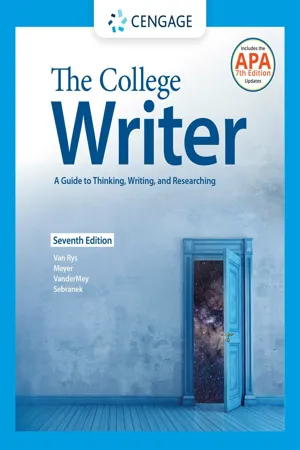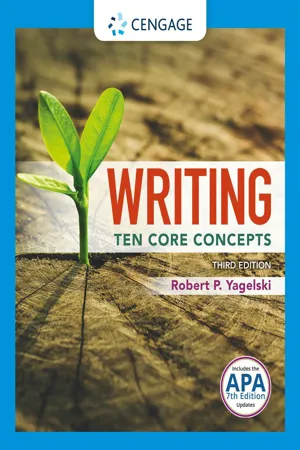Languages & Linguistics
Process Analysis Rhetorical Mode
Process Analysis Rhetorical Mode is a writing strategy that explains how something works, how to do something, or how something is made. It involves breaking down a complex process into smaller steps and presenting them in a logical order. This mode is commonly used in technical writing, instructional manuals, and recipes.
Written by Perlego with AI-assistance
Related key terms
1 of 5
3 Key excerpts on "Process Analysis Rhetorical Mode"
- eBook - PDF
Style
An Introduction to History, Theory, Research, and Pedagogy
- Brian Ray(Author)
- 2014(Publication Date)
- Parlor Press, LLC(Publisher)
Researching Style: Methods in Rhetoric, Composition, and Related Disciplines 165 ment over patterns of language. In Out of Style , Paul Butler asserts that stylistic analysis has been subsumed into rhetorical analysis and, consequently, receives less attention than it could. For Butler, rhetori-cal analysis may devote passing attention to an author’s or speaker’s use of a few tropes, schemes, and figures, but it often falls short of fully appreciating the extent to which language choices contribute to more global meanings. For instance, it is almost impossible to conduct a rhetorical analysis of a speech like Martin Luther King’s “I Have a Dream” without some attention to King’s use of anaphora and meta-phor. A thorough rhetorical analysis would ideally make substantial connections between a rhetor’s purpose, use of evidence, awareness of audience, and manipulation of language to achieve that purpose. Despite the wide array of frameworks for analyzing arguments, it is possible to describe a general approach and set of methods, as Jack Selzer does in What Writing Does and How it Does it . Selzer defines rhetorical analysis as “studying carefully some kind of symbolic action, often after the fact of its delivery,” in order to achieve “a heightened awareness of the message under rhetorical consideration, and an ap-preciation for the ways people manipulate language and other symbols for persuasive purposes” (281). In Discourse Studies and Composition , Jeanne Fahnestock and Mary Secor define some specific questions ad-dressed by rhetorical analysis: “How is the speaker of this text being constructed? How is the audience constructed? How is the argument constructed? And how do these three aspects either reinforce or inter-fere with each other?” (180). Regarding methods, rhetorical analysis often proceeds this way: Writers summarize a text’s main argument or arguments, and list its major claims. They then lay out the evidence in support of each claim. - John Van Rys, Verne Meyer, Randall VanderMey, Patrick Sebranek, John Van Rys(Authors)
- 2021(Publication Date)
- Cengage Learning EMEA(Publisher)
The Modes as Thinking Frameworks Each rhetorical mode involves a thinking move that allows you to deepen your understanding of a topic, to explore it and make claims about it. Personal-Writing Modes Personal-writing modes focus on experience, especially the writer’s experience—whether of places, people, or events—with the goal of vividly sharing that experience with readers. (See chapter 10.) • Narration tells a story, whether in the form of a brief anecdote, a personal essay, a short story, or a book-length novel. • Description evokes material reality (e.g., birds outside a window) through appealing to the senses (sight, hearing, touch, taste, and smell). • Reflection involves rumination—a kind of speculation that extends narration and description toward personal and universal meaning. Analytical Modes Analytical modes involve mentally “breaking down” a topic in an effort to reveal structures and logical relationships that hold it together. • Definition seeks to clarify the meaning of a term or concept (e.g., human trafficking, mathematics, excellence). (See chapter 11.) • Classification organizes into categories large or complex sets of things: weight lifters and their motivations, musical genres popular in Latin America, or positions on climate change. (See chapter 12.) • Process analysis explains how a specific phenomenon unfolds in time—stage by stage, step by step. The phenomenon might be natural (the development of cancer), historical (emancipation), or cultural (end-of-life care). (See chapter 13.) • Compare-contrast analysis examines the similarities and/or differences between two or more topics in order to illuminate their distinctiveness and/or their commonalities, whether the topics are cultural characteristics, human and animal suffering, or traditional and cyber bullying. (See chapter 14.) • Cause-effect analysis examines the forces that bring about specific results—focusing on the forces at work (causes), the results (effects), or both.- Robert Yagelski(Author)
- 2021(Publication Date)
- Cengage Learning EMEA(Publisher)
Rhetorical analysis illuminates how a text reflects a rhetorical purpose and whether that text is likely to be persuasive to that audience. In this regard, rhetorical analysis addresses three main questions: ■ What are the main features of the text? ■ How do those features affect the intended audience? ■ Why did the writer include those features and craft the text in specific ways? Notice that in rhetorical analysis, you are not evaluating the message itself but how the message is conveyed. The point of rhetorical analysis is not to agree or disagree with the message but to examine how effectively the message is conveyed to an audience. There are a variety of methods for conducting a rhetorical analysis. What follows is a discus- sion of three main methods, or frameworks, for rhetorical analysis: basic rhetorical analysis, classical rhetorical theory, and stylistic analysis. © The State of North Dakota, Department of Human Services 8 Copyright 2022 Cengage Learning. All Rights Reserved. May not be copied, scanned, or duplicated, in whole or in part. Due to electronic rights, some third party content may be suppressed from the eBook and/or eChapter(s). Editorial review has deemed that any suppressed content does not materially affect the overall learning experience. Cengage Learning reserves the right to remove additional content at any time if subsequent rights restrictions require it. 228 Chapter 8 | Conducting Rhetorical Analysis Basic Rhetorical Analysis In its most basic form, rhetorical analysis is a matter of explaining a text in terms of the main ele- ments of the rhetorical triangle: writer, audience, and purpose (see page 27 in Chapter 2).
Index pages curate the most relevant extracts from our library of academic textbooks. They’ve been created using an in-house natural language model (NLM), each adding context and meaning to key research topics.


